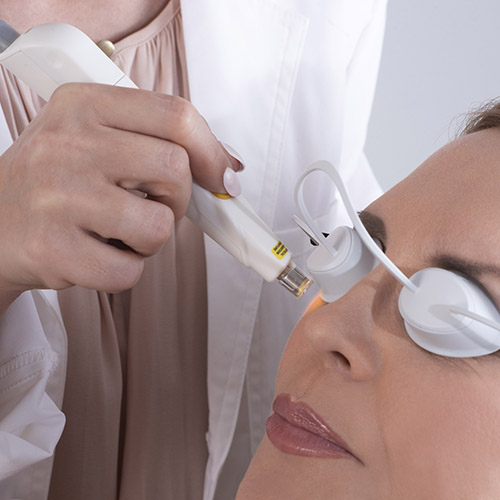.jpg?width=500&height=500&ext=.jpg)
.jpg?width=500&height=500&ext=.jpg)
Dry eye disease is becoming increasingly common, affecting millions of people worldwide. This chronic condition can significantly impact your life, sometimes making even the smallest of tasks seem difficult.
If you have eye pain, blurry vision, and dry or watery eyes, it could be a sign you have dry eye disease. But don’t worry! With an in-depth eye exam, our team can assess your vision and eye health to get you the treatment you need.
With treatments like OptiLight by Lumenis, we can help manage your dry eye symptoms and get you back to seeing clearly and comfortably.
Dry eye disease
Dry eye disease is a common eye condition that occurs when there is an issue with any one of the three components of your tears. Your tears are made up of three distinct layers, all of which work together to keep your eyes healthy:- The oily layer prevents your tears from evaporating too quickly.
- The watery layer delivers nutrients to your eyes.
- The mucus layer keeps your tear film stuck to the surface of your eyes.
There are two types of dry eye disease, evaporative dry eye (EDE) and aqueous tear deficiency (ATD).
- Evaporative Dry Eye (EDE): EDE is the most common type of dry eye disease. This type of dry eye occurs when you lack the proper amount of oil in your tears. When this happens, your tears can evaporate too quickly, drying out your eyes. In some cases, EDE can be caused by meibomian gland dysfunction, a disorder where the meibomian glands in your eyes become blocked, limiting the amount of oil being produced for your tears.
- Aqueous Tear Deficiency (ATD): If you suffer from ATD, your eyes lack the aqueous layer in your tears. This means that your eyes aren’t producing enough tears to keep the eye moist, which can lead to irritating and uncomfortable symptoms.
Causes of dry eye disease
Dry eye disease can be attributed to several factors:
- Prolonged exposure to screens (digital eye strain).
- Winter air that can be more irritable than summer air.
- Certain types of contacts that stop the oxygen flow to the eyes.
- Side effects from medications such as antihistamines.
- Sustained time spent in particularly windy or smoky areas.
- In women, hormonal changes caused by aging or menopause.
- Other health disorders like rheumatoid arthritis and thyroid problems.
Symptoms of dry eye disease
If you are suffering from dry eye disease, you may notice any of the following symptoms:
- A burning or scratchy sensation in your eyes.
- Stringy mucus in or around your eyes.
- Irritated or overly watery eyes.
- Sensitivity to light or photophobia.
- Eye redness, blurred vision or eye fatigue.
- A sensation of having something in your eyes.
- Difficulty wearing contact lenses.
If you are experiencing any of these symptoms, schedule an appointment with your eye doctor to receive a dry eye disease diagnosis and get the treatment you need.
Treatment options for dry eyes
There are various conservative treatment options for dry eyes such as over the counter and prescription eye drops and steroids. You can also try some home remedies such as using a humidifier, using warm compresses on your eyes and avoiding wind and smoke.
If dry eyes still persist, Prevea also offers OptiLight by Lumenis. It is a safe, gentle and effective treatment done to manage dry eye disease. This non-invasive procedure is the first and only FDA-approved intense pulsed light (IPL) treatment for dry eye management.
OptiLight uses pulses of light precisely administered in the area below the eyes to reduce dry eye symptoms. This 10- to 15-minute procedure can relieve dry eye symptoms by:
- Increasing tear break-up time.
- Reducing the amount of demodex mites and bacteria around your eyes.
- Decreasing inflammation.
- Improving meibomian gland functionality.
While side effects are uncommon, your eyes may feel slightly more dry or gritty for the day following your procedure. If you do experience dry eyes, you can use preservative-free artificial tears.
OptiLight by Lumenis is available for $1,400. This includes all four treatments for complete care.
Find relief today
You don’t have to live with the uncomfortable symptoms of dry eye disease. Your symptoms can be managed effectively and efficiently, restoring your quality of life.Our experts are always here to help you find relief from dry eyes. Schedule an appointment today to see how we can help you!


